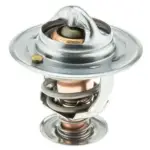A camshaft plays a vital role in the engine by synchronizing the intake and exhaust valves of an engine to the crankshaft’s rotation. The camshaft’s function is to open and close the intake and exhaust valves at the right time so that the engine can run smoothly. It does this by turning rotational motion into a linear motion. The camshaft position sensor tells the Engine Control Module (ECM) how fast the camshaft is rotating, so that the ECM can time the ignition cycle of the engine.

You may notice that some engines say SOHC or DOHC this stands for single or double overhead cam. What this means is that the engine either has one camshaft for both the intake and exhaust valves, or the intake and exhaust valves have their own individual camshaft. The overhead simple indicates that the camshaft is located above the valves. On pushrod engines, the camshaft is located below the valves and utilizes rods to open and close the valves. Before we discuss symptoms of a failing camshaft, it is important to understand how it works.
How a Camshaft Works
A camshaft is driven by the crankshaft in the engine. The crankshaft is rotated by the combustion forces happening in the engine’s cylinders. The camshaft is connected to the crankshaft via a timing chain, belt, or gears.
The crankshaft rotations have to be precisely matched to the camshaft rotation so that the valves open and close at the right time. So how does the camshaft open and close the valves as it rotates?

The camshaft is made up of a circular rod with oddly shaped lobes. These non-circular lobes have been carefully designed to lift the valves to precise heights. Car and truck engines running on a four stroke cycle: intake, compression, combustion, and exhaust. In order for the engine to intake air and fuel into the cylinder the intake valves will have to open. After the compression and combustion strokes, the exhaust valves will open via the camshaft.
The camshaft turns rotational motion from the engine’s crankshaft into linear motion of the intake and exhaust valves. The camshaft is able to do this because of its lobes. Each lobe will press down the valve, opening the valve, for a portion of the shaft’s rotation. The other part of the camshaft’s rotation will release the valve causing the valve spring to close the valve. The valve spring forces the valve closed when the camshaft’s lobe is no longer blocking it.
The camshaft position sensor’s job is rather self explanatory, but its job is to report the camshaft speed to the Engine Control Module (ECM). The ECM will then determine the ignition timing for each cylinder in the engine. It is critical that this sensor is functioning correctly, otherwise the valves will be opening and closing at the wrong times causing all sorts of problems.
Symptoms of a Bad Camshaft Position Sensor
Because of how essential the camshaft is to an engine’s function and performance, it is important to be able to recognize the signs of that the camshaft is failing.
1. Rough Idle/Stalling
Rough idling and stalling can be a symptom of a bad camshaft position sensor. A faulty position sensor will mean that the ECM will not be able to synchronize the camshaft’s rotation to the crankshaft rotation. This will cause the valves to open and close at the wrong times. This will cause a noticeable change in performance as well. This is a critical issue as the engine could even cut out and die while driving. If you think that you have a faulty camshaft position sensor, have it inspected by mechanic as soon as possible.
2. Vehicle Will Not Start
In addition to causing problems while running, a camshaft position sensor could also cause a vehicle not to start. If the intake valves don’t open at the right time, the fuel and air mixture will not make it into the cylinder before the combustion stroke. If there’s minimal to no fuel or air in the cylinder during the combustion stroke, the engine won’t be able to run.
Another way the camshaft position sensor could prohibit the engine from starting is by failing to tell the ECM that it is on at all. If no signal is given to the ECM by the camshaft position sensor, the ECM will shut the engine off.
3. Check Engine Light
One of the worst lights to see on your dashboard, the check engine light can also be triggered by a faulty position sensor. A check engine light can be triggered by many different problems. That is why it is important to always have your vehicle inspected as soon as the check engine light comes on.
4. Backfiring
Another symptom of a faulty camshaft position sensor is backfiring. Backfiring is caused by combustion happening in the exhaust manifold of the vehicle. This can also be a cause of the camshaft opening the exhaust valves to early so that excess fuel is sent to the exhaust. This fuel can be ignited in the exhaust by the extremely high temperatures causing backfires.
5. Valve Tapping or Ticking Noise
Valve tapping or ticking can be related to the camshaft itself. The camshaft has open and close the valves to precise distances. Over time, the lobes on the cam can wear causing excess play in the valves in the open condition. When the engine is running you can sometimes hear the valves shift around and make a ticking noise. It should be noted that valve ticking can also be caused by low oil levels, low oil pressure, the exhaust manifold, worn components, and other reasons.
If you think your vehicle has a faulty camshaft or camshaft position sensor, don’t drive the vehicle. Have the car inspected as soon as possible. A bad camshaft or sensor can cause serious engine problems that if left unchecked can cause total engine failure, or even worse safety issues if the engine cuts out while driving.
Replacing a camshaft is a very in depth job as sensitive components of the engine have to be disassembled. If you are not experienced in automotive repair, its best to leave this job to professional mechanics.



